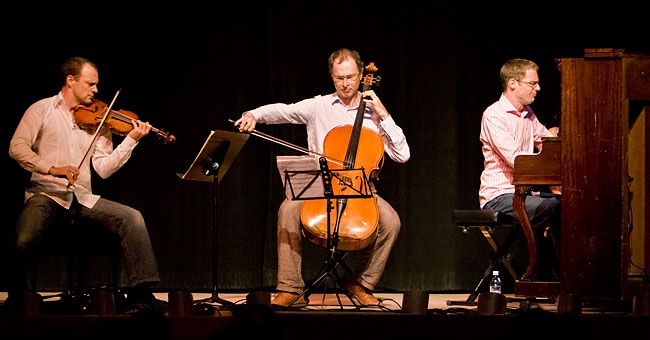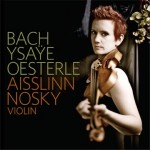
They may not have big labels behind them to promote international tours, but that doesn’t mean Canadian classical musicians don’t have something remarkable to say. Two prime examples with recent new albums are violinist Aisslinn Nosky and the Triple Forte piano trio:
- Classical Music 101: What Does A Conductor Do? - June 17, 2019
- Classical Music 101 | What Does Period Instrument Mean? - May 6, 2019
- CLASSICAL MUSIC 101 | What Does It Mean To Be In Tune? - April 23, 2019
 TRIPLE FORTE
TRIPLE FORTE
Ravel, Shostakovich & Ives Piano Trios (ATMA)
Despite what this trio’s name might suggest, pianist David Jalbert, violinist Jasper Wood and cellist Yegor Dyachkov excel in fine nuance, not noise. Nor are they noisy self-promoters: People who love going to hear chamber music at summer festivals have likely tripped across this threesome, but they’ve otherwise kept a low profile — perhaps because each member is a soloist in his own right, as well as being a teacher.
But their musicmaking together is remarkable, focused and polished over the course of many seasons spent playing in smaller cities and towns as far afield as the Yukon. (Triple Forte was founded in 2003 with cellist Denise Djokic, who went her own way a couple of years later.)
For their début album, these boys have assembled three very different examples of art music from the first quarter of the 20th century: the ethereal impressions of Maurice Ravel in his popular 1914 Trio; residual late-Romanticism in Dmitri Shostakovich’s effusive teenaged love letter Trio from 1923; and Charles Ives patchwork quilt Trio of musical experimentation from 1911.
Changing rhythmic and expressive gears with deceptive ease, the boys of Triple Forte amaze with their technical ease, and entrance with their single-minded grace. They find a sensible balance between musical muscle and subtle expression throughout.
The Ravel is smooth and delicate; the Shostakovich is heartfelt and earnest; and the Ives, well, is a particular treat.
Considered too fearsome for anyone to tackle in public until 1948, this trio is a terribly disjointed work, with no obvious relationship between its three movements. Most remarkable are the last two, where Ives takes the definition of scherzo (joke) literally and poking it in the eye with salsa sauce, garlic aioli redundancy by labelling it TSAJ — This Scherzo is a Joke. It’s an excuse for Ives to engage in one of his favourite pastimes: Having unrelated melodies, keys and rhythmic patterns (many of them borrowed from Yale University frat-boy drinking songs) play over each other in a mad cacophony.
Then the music, all sobered up and filled with regret for its antics, turns around in an elegiac finale, given a particularly warm inner glow by Jalbert, Wood and Dyachkov.
For more details, as well as audio samples, click here.
 AISSLINN NOSKY
AISSLINN NOSKY
Bach, Ysaÿe, Oesterle (www.aisslinn.com)
Not satisfied with a full professional life as a longtime member of Tafelmusik and founder of I Furiosi Baroque Ensemble and Eyber Quartet in Toronto, and her year-old additional job as concertmaster of Boston’s venerable Handel & Haydn Society, Aisslinn Nosky has decided to climb three musical mountains all by herself in her self-produced début album.
The effort is anchored on the E-Major Partita by Johann Sebastian Bach (BWV 1006), one of the six solo Sonatas and Partitas that are the basis for any violinist’s core training. The Prelude and five ensuing movements based on French courtly dances of the late 17th century are not only the ultimate test of a violinist’s skill, they are beautiful music.
Nosky performs the suite with an elegance that belies the Bach’s technical challenges, underpinning her interpretation with a compelling pulse.
She has cleverly rounded out the album with modern pieces that echo the style and patterns of Bach’s Partita: The daunting Sonata No. 2 (Op. 27) by Belgian violinist Eugène Ysaÿe (1858-1931) and Stand Still, a piece commissioned in 2011 from Canadian composer Michael Oesterle.
Here, Nosky further shows off her mettle in music that obsessively plays with themes, sometimes sweetly, but often with fire – and even anger. This is not easy listening by any stretch of the imagination, but a compelling showcase for a fearsomely powerful musician and imaginative composer who stretch the limits of two hands and four strings to draw out a wide spectrum of colour and drama.
For all the details, click here.
John Terauds
- Classical Music 101: What Does A Conductor Do? - June 17, 2019
- Classical Music 101 | What Does Period Instrument Mean? - May 6, 2019
- CLASSICAL MUSIC 101 | What Does It Mean To Be In Tune? - April 23, 2019



